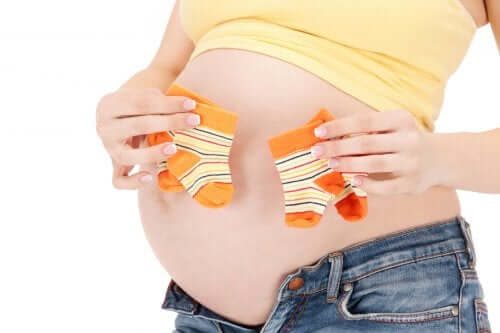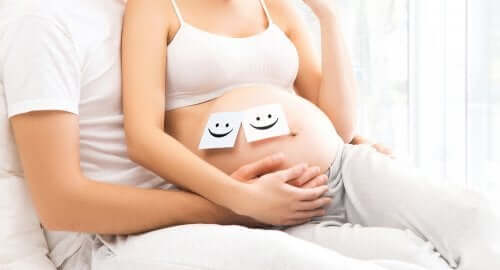Analyzing the Rise in the Twin Birth Rate

Over the years, the twin birth rate has increased. In the following article, we’ll analyze why more and more twins are being born nowadays. Discover the reasons below!
The twin birth boom has taken the world by storm. In fact, every year, the record of twin births breaks the previous year’s record.
There are two reasons why this is happening. On the one hand, women are waiting until they’re older to become mothers. This is because, after age 35, the likelihood of multiple births increases. The other reason is due to the medical treatment undergone by women who have a hard time getting pregnant.
As we mentioned above, this phenomenon is affecting all industrialized countries. Below, you’ll discover what’s causing the rise in the twin birth rate and its consequences.
The rise in the twin birth rate
Below, discover the main causes of the twin birth boom. Take note!
1. Increasingly late motherhood
One study noted that the likelihood of twin pregnancy increases as women age. In fact, this is one of the main reasons for this boom.
According to researchers, the age when a woman becomes pregnant is one of the factors that most influences the odds of having twins (or more), along with birth order and region of the world, if only spontaneous and unassisted pregnancies are taken into account.

The reasons why delayed births are on the rise are well-known: there are more and more occupationally active women and the desire to have a job and a partner before having children.
But as women age, their levels of the hormone responsible for ovulation increase, which is why the probability of two eggs being fertilized at the same time also increases.
2. Increased fertility aids have led to an increased twin birth rate
However, the main factor behind the rise in the twin birth rate is medically assisted procreation, as it makes it three times more likely to cause twin births than late motherhood.
More and more women are turning to assisted reproductive technology (such as ovarian stimulation and in vitro fertilization), which translates into the main reason for this rise.
In particular, in vitro fertilization consists of implanting several embryos at the same time to maximize the chances of pregnancy. This also increases the chances of having twins. In fact, after age 35, ovarian stimulation is common and, at the same time, more and more couples resort to assisted reproduction drugs.
Due to the fact that women become less fertile as they age, the category of people who resort to such treatments also represents women over 35. This trend isn’t without problems. Twins are usually more fragile than other newborns. They tend to weigh less, they’re likely to be born premature, and giving birth to twins is often more complicated.
Consequences of twin births
Medical professionals and experts never consider twin births to be simple. Having twins impacts both the mother and her babies’ health. The babies run out of space faster in the womb, which can trigger premature delivery.

Unfortunately, this is also related to greater health risks, due to the frequent use of Caesarean section and an increased risk of hypertension and gestational diabetes. In fact, many pregnant women dread Caesarean sections – even if the idea of not having to endure a double childbirth is sometimes a relief, not being able to give birth naturally is also disappointing to them.
As you may have seen, there are mainly two reasons why the twin birth rate has risen: women are increasingly delaying childbearing and there has been an increase in the use of fertility treatments. In any case, the arrival of identical and fraternal twins is a unique experience for all moms!
Over the years, the twin birth rate has increased. In the following article, we’ll analyze why more and more twins are being born nowadays. Discover the reasons below!
The twin birth boom has taken the world by storm. In fact, every year, the record of twin births breaks the previous year’s record.
There are two reasons why this is happening. On the one hand, women are waiting until they’re older to become mothers. This is because, after age 35, the likelihood of multiple births increases. The other reason is due to the medical treatment undergone by women who have a hard time getting pregnant.
As we mentioned above, this phenomenon is affecting all industrialized countries. Below, you’ll discover what’s causing the rise in the twin birth rate and its consequences.
The rise in the twin birth rate
Below, discover the main causes of the twin birth boom. Take note!
1. Increasingly late motherhood
One study noted that the likelihood of twin pregnancy increases as women age. In fact, this is one of the main reasons for this boom.
According to researchers, the age when a woman becomes pregnant is one of the factors that most influences the odds of having twins (or more), along with birth order and region of the world, if only spontaneous and unassisted pregnancies are taken into account.

The reasons why delayed births are on the rise are well-known: there are more and more occupationally active women and the desire to have a job and a partner before having children.
But as women age, their levels of the hormone responsible for ovulation increase, which is why the probability of two eggs being fertilized at the same time also increases.
2. Increased fertility aids have led to an increased twin birth rate
However, the main factor behind the rise in the twin birth rate is medically assisted procreation, as it makes it three times more likely to cause twin births than late motherhood.
More and more women are turning to assisted reproductive technology (such as ovarian stimulation and in vitro fertilization), which translates into the main reason for this rise.
In particular, in vitro fertilization consists of implanting several embryos at the same time to maximize the chances of pregnancy. This also increases the chances of having twins. In fact, after age 35, ovarian stimulation is common and, at the same time, more and more couples resort to assisted reproduction drugs.
Due to the fact that women become less fertile as they age, the category of people who resort to such treatments also represents women over 35. This trend isn’t without problems. Twins are usually more fragile than other newborns. They tend to weigh less, they’re likely to be born premature, and giving birth to twins is often more complicated.
Consequences of twin births
Medical professionals and experts never consider twin births to be simple. Having twins impacts both the mother and her babies’ health. The babies run out of space faster in the womb, which can trigger premature delivery.

Unfortunately, this is also related to greater health risks, due to the frequent use of Caesarean section and an increased risk of hypertension and gestational diabetes. In fact, many pregnant women dread Caesarean sections – even if the idea of not having to endure a double childbirth is sometimes a relief, not being able to give birth naturally is also disappointing to them.
As you may have seen, there are mainly two reasons why the twin birth rate has risen: women are increasingly delaying childbearing and there has been an increase in the use of fertility treatments. In any case, the arrival of identical and fraternal twins is a unique experience for all moms!
All cited sources were thoroughly reviewed by our team to ensure their quality, reliability, currency, and validity. The bibliography of this article was considered reliable and of academic or scientific accuracy.
- Pison, G., Monden, C., & Smits, J. (2015). Twinning rates in developed countries: trends and explanations. Population and Development Review, 41(4), 629-649. https://onlinelibrary.wiley.com/doi/full/10.1111/j.1728-4457.2015.00088.x
This text is provided for informational purposes only and does not replace consultation with a professional. If in doubt, consult your specialist.








